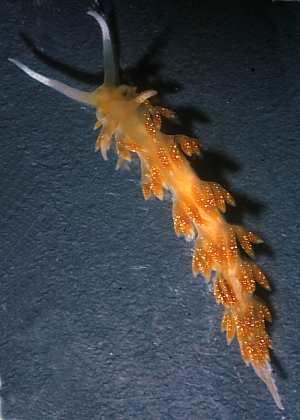
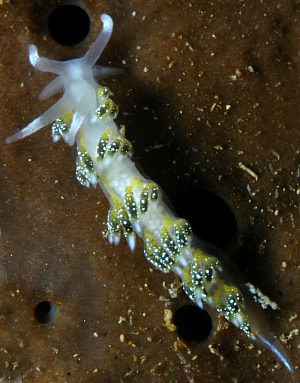
Tularia bractea
(Burn, 1962)
Order: NUDIBRANCHIA
Suborder: AEOLIDINA
Family: Flabellinidae
DISTRIBUTION
South-eastern Australia and New Zealand
PHOTO
Upper:Waiwera, east coast, nth of Auckland, 22 June 1963 [6 specimens on hydroids on Carpophyllum]. Photo M.C. Miller. Lower: Poor Knights Islands, 15 m, New Zealand, Pacific Ocean, 26 August 2007, Rocky reef. Length: 10 mm. Photo: Ian Skipworth.
The only information we have on this species is the original description (Burn, 1962) and a later redescription (Burn, 1966) of animals from Victoria, Australia, and Miller's full account (1971) of animals from New Zealand. Burns' description of the external features are not very clear, but fortunately in his 1966 redescription he describes the presence of lateral radular teeth, which with the ceratal arrangement and tentacular anterior foot corners, allowed Miller to identify his New Zealand specimens as this species. My description below, of the colour and external features, is based on the photos on the Forum of NZ specimens from Michael Miller and Ian Skipworth.
The animal is elongate with long tapering oral tentacles, and shorter, but similarly shaped, rhinophores which sometimes can have a wrinkled ventral section. The cerata are arranged in spaced rows, each row being on a ridge or bracket jutting out from the body. The first two rows of cerata on each side are quite close together, and because the cerata in the first row are quite small, this row can sometimes be overlooked, especially in photographs. Behind these first two rows the ceratal rows are regularly spaced at much wider intervals. The genital openings are on the right side between the second and third ceratal rows, and the heart is situated dorsally between the third and fourth rows. The anus and kidney openings are on the right side in the same space. The anterior end of the foot is extended into quite long tentacular foor corners.
The body wall is translucent white to transparent, with the whitish body organs showing through. Sometimes there can be a reddish orange or yellowish tinge over all the body wall, and in some animals there can be small brownish spots scattered all over the body and ceratal walls. There are usually opaque white spots scattered over the ceratal wall. Both the oral tentacles and rhinophores have a broad subapical band of opaque white, the actual tip being translucent. The posterior tip of the foot can also be opaque white and in some case there can be an opaque white median line running forward to the last ceratal row. The most distinctive part of the colour pattern is the colour of the digestive gland duct which runs along the length of the 'bracket' on which each row of cerata are attached, and sends a branch up into each ceras. The colour of the duct varies from yellow, orange, green or reddish brown, the colour intensifying in the upper half to a third of each ceras, just below the whitish cnidosac.
This species grows to about 17 mm in length. The triseriate radula and shape of the lateral teeth caused Burn (1966) to place the genus in the Eubranchidae, but Miller considered most other anatomical features suggest it is a flabellinid.
- Burn, R.F. (1962) Descriptions of Victorian nudibranchiate mollusca, with a comprehensive review of the Eolidacea. Memoirs of the National Museum of Victoria, 25: 95-128.
-
Burn, R.F. (1966) Descriptions of Australian Eolidacea (Mollusca: Opisthobranchia). 3. The genera Tularia, Embletonia and Austraeolis, with a note on Tergipes pauculas Burn, 1962. J. Mal. Soc. Aust., 9: 25-35.
-
Miller, M. C. (1971) Aeolid nudibranchs of the family Flabellinidae and Eubranchidae from New Zealand waters. Zoological Journal of the Linnean Society, 50: 311-337.
Rudman, W.B., 2007 (September 10) Tularia bractea (Burn, 1962). [In] Sea Slug Forum. Australian Museum, Sydney. Available from http://www.seaslugforum.net/find/tulabrac
Related messages
Tularia bractea from eastern Australia
March 25, 2008
From: Leanne & David Atkinson
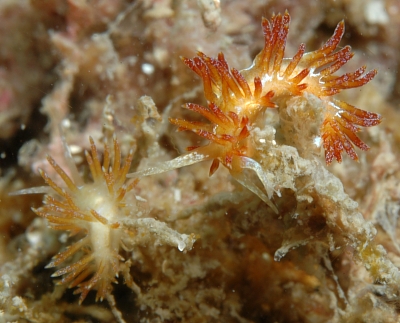
Dear Bill,
Over the last month we have repeatedly found this beautiful tiny Aeolid nudibranch in great numbers at both The Pipeline and Halifax. We haven't seen it before. It seems to be an Aeolid in shape. The ones we found at Halifax were on a number of different soft weedy things including the brown hydroid that Flabellina rubrolineata eats. We found them in greater numbers and with lots of eggs on Amathia tortuosa. Dave Harasti has also found it and is listing it on his web site as a new discovery and is calling it Fiery Phidiana, an appropriate name given the colours. We had started looking for it as a Flabellina. Neville Coleman has a similar photo listed as colour variation of Tularia bractea. What do you think? Can you suggest some identifying external features to differentiate a Flabellina from a Phidiana and a Tularia or is it all internal anatomy? Your help with this would be greatly appreciated.
Locality: The Pipeline and Halifax Sponge Gardens Port Stephens, 5metres to 17 metres, New South Wales, Australia, Pacific Ocean, 11 October and 14 October 2007, Sandy bottom with scattered sponges, hydroids, gorgonians, soft corals, ascidians, seaweeds and algae. Length: up to 15 mm. Photographer: Leanne & David Atkinson.
Best wishes,
Leanne & David Atkinson
atk@hunterlink.net.au
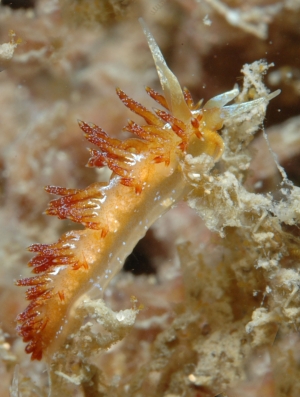
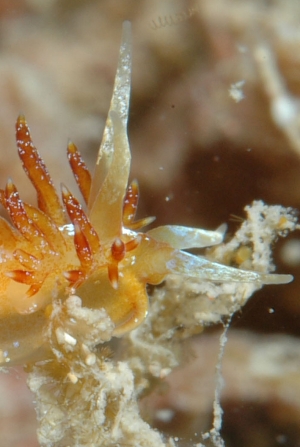
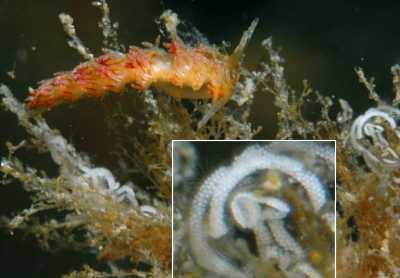
Dear Leanne & David,
This is an interesting find and I am pretty sure it is a colour form of Tularia bractea, although as usual - we would need to check its anatomy. That species has been previously reported from so far up the east coast of Australia but, previously been known from the Bass Strait region and New Zealand.
It is clearly not a species of Phidiana, or related genera, which have the cerata arranged in rows, but the rows are arranged in regular groups or clusters of up to 6 rows. The smooth rhinophores and long tentacular anterior foot corners are characters of Tularia, but probably the most characteristic feature are the ridges (or 'bracts') on which the cerata are inserted. very few aeolids have such pronounced structures.
Concerning them being on the bryozoan Amathia tortuosa. In your photo with the eggs, all I can see are hydroids. I have looked carefully at the full size files of your other two photos but can't see any sign of Amathia. All I can suggest is that the ones you saw on Amathia were there because the bryozoan had settled and grown on hydroid colonies which had been eaten out by the aeolid. Often when you see great numbers of egg ribbons on a hydroid colony you can be sure when you look closely that most of the hydroid polyps have been destroyed. I am afraid the life cycle of aeolids is quite short and brutal. They settle on a colony of hydroids and quickly eat all the polyps. If the colony is large enough the aeolid population will be able to mate and lay their eggs before the adult either die from old age or starvation.
Best wishes,
Bill Rudman
Another Tularia bractea from New Zealand?
September 11, 2007
From: Ian Skipworth
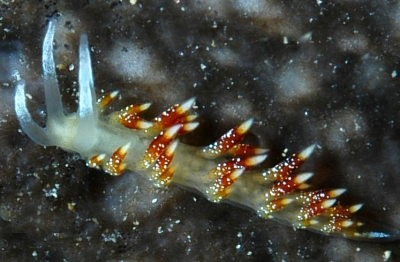
Hi Bill
These two photographs are of two different slugs taken on different dives but are fairly clearly the same animal. They have me a bit confused because they look similar, apart from colour, to slugs which I have been calling Cuthona scintillans and also bear some resemblance to Flabellina albomarginata which are fairly common at the Poor Knights at the moment.
I will also post photos of these other slugs for comparison.
Locality: Poor Knights Islands, 12 metres, New Zealand, Pacific Ocean, 26 August 2007 , Rocky reef. Length: 9 mm. Photographer: Ian Skipworth.
Your comments would be much appreciated.
Cheers
Ian
ianskip@xtra.co.nz
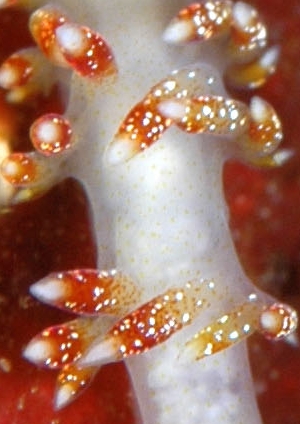
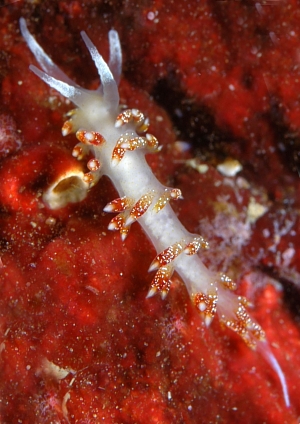
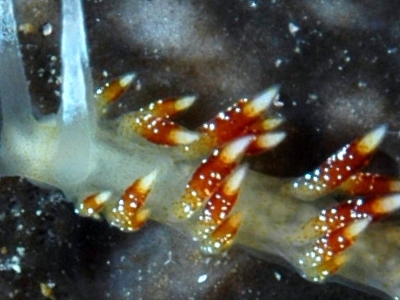
Dear Ian,
I am glad you were puzzled by this animal and the green ones in your other message [#20678], otherwise we might never have seen your photos. I am pretty sure you are right in thinking these animals and the green ones in your earlier message are the same species, and I suspect that it is Tularia bractea. What I would really need to confirm it is a photo of the front end, so I can see whether the front corners of the foot are rounded or tentacular. In your green animal [message #20678] the tentacular foot corners are very visible, and without knowing anything of the anatomy of your animals, it would be a valuable way of confirming that its Tularia. Any photo - even if everything else is out of focus - would be welcome.
Both these slugs have fine brownish spots all over the skin, something which is apparently absent from the greenish ones.
Best wishes,
Bill Rudman
Tularia bractea from New Zealand
September 11, 2007
From: Bill Rudman
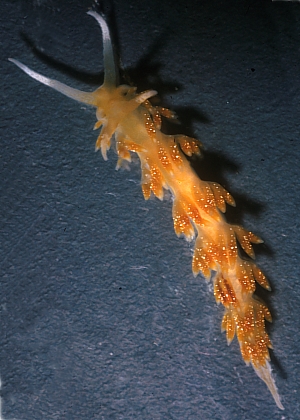
A couple of years ago Michael C. Miller, who as published widely on the New Zeland nudibranch fauna, allowed me to scan a selection of his slides of the New Zealand fauna for use on the Forum. I had planned to post them all quite quickly but I obviously have more enthusiasm than time, so I gradually posting hisphotos as time allows. Many of them represent species which have not previously been illustrated, or are animals Michael Miller used when preparing the beautiful water colour paintings which accompany many of his descriptions.
To accompany two messages from Ian Skipworth [#20678, #20677 ] which I have identified as Tularia bractea , here is a photo of an animal that Michael Miller has identified as that species, and formed part of his description.
Locality: Waiwera, east coast, nth of Auckland, 22 June 1963 [6 specimens on hydroids on Carpophyllum ]. Photo: M.C.Miller
This is particularly valuable as the only information we have on this species is the original description (Burn, 1962) and a later redescription (Burn, 1966) of animals from Victoria, Australia in which the external features are not very clear. Fortunately in Burn's redescription he describes the presence of lateral radular teeth, which with the ceratal arrangement and tentacular anterior foot corners, allowed Miller to identify his New Zealand specimens as this species. The description on the Fact Sheet of the colour and external features is based on the photos on the Forum of NZ specimens from Michael Miller and Ian Skipworth.
-
Burn, R.F. (1962) Descriptions of Victorian nudibranchiate mollusca, with a comprehensive review of the Eolidacea. Memoirs of the National Museum of Victoria, 25: 95-128.
-
Burn, R.F. (1966) Descriptions of Australian Eolidacea (Mollusca: Opisthobranchia). 3. The genera Tularia, Embletonia and Austraeolis, with a note on Tergipes pauculas Burn, 1962. J. Mal. Soc. Aust., 9: 25-35.
-
Miller, M. C. (1971) Aeolid nudibranchs of the family Flabellinidae and Eubranchidae from New Zealand waters. Zoological Journal of the Linnean Society, 50: 311-337.
Bill Rudman
Rudman, W.B., 2007 (Sep 11) Tularia bractea from New Zealand. [Message in] Sea Slug Forum. Australian Museum, Sydney. Available from http://www.seaslugforum.net/find/20681Tularia bractea from New Zealand
September 11, 2007
From: Ian Skipworth
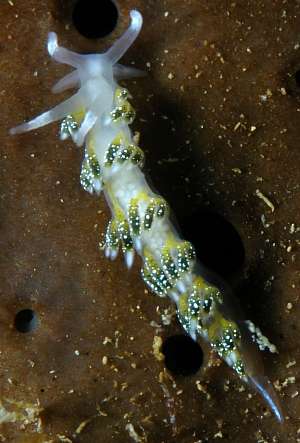
Hi Bill
I have been calling this slug Cuthona scintillans.
It does bear some resemblance to the red hued slug [message #20677 ] which I posted to you recently and this is making me a bit less confident about its identification. Comments appreciated, as always.
Locality: Poor Knights Islands, 15m, New Zealand, Pacific Ocean, 26 August 2007, Rocky reef. Length: 10mm. Photographer: Ian Skipworth.
Cheers
Ian
ianskip@xtra.co.nz
Skipworth, I.R., 2007 (Sep 11) Tularia bractea from New Zealand. [Message in] Sea Slug Forum. Australian Museum, Sydney. Available from http://www.seaslugforum.net/find/20678
Dear Ian,
Looking back at my previous answers to you about Cuthona scintillans, I see that in one of your messages [#15192] I have apparently misled you. I am pretty sure that animal is the same species as this animal - which is Tularia bractea. In that previous message you can't see the tentacle like corners at the anterior edge of the foot, which would preclude it as being a Cuthona. Also I wasn't really expecting T. bractea to have a green form. In this present specimen the very obvious tentacular foot corners in your photo immediately made identifying this as Cuthona scintillans impossible.
As you will see I am posting a photo from Michael Miller of this species from New Zealand and a Fact Sheet. I am pretty sure your reddish animal in a separate message [#20677] is Tularia bractea as well.
In the close-up alongside in the region between ceratal rows 3 and 4 from the front you can see the anus [an] and the position of the heart [h]. Because it is transparent the heart is often hard to see in photos, but if you see the animal alive you can usually see the pericardial sac as a raised bump in the middle of the back, and you can usually see the heart vigorously beating away inside. In this photo, the yellowish green bands are the shared digestive gland ducts in the body and the ceratal brackets I mention in the Fact Sheet. The colour of the digestive gland duct intensifies within each ceras.
Best wishes,
Bill Rudman
Cuthona scintillans from New Zealand
November 8, 2005
From: Ian Skipworth
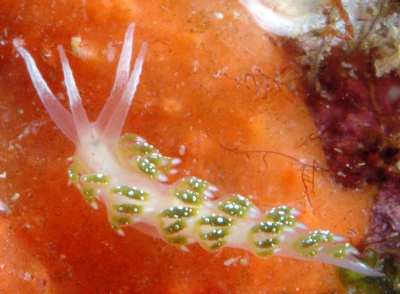
Hi Bill
I came across this wee nudibranch nudibranch on a dive yesterday. I've not seen this one before but guess it's Cuthona scintillans.
Locality: Poor Knights Islands, NE New Zealand. Depth: 18 m. Length: 10 mm. 05 November 2005. Rocky reef. Photographer: Ian Skipworth
Your comments would be appreciated.
Cheers
Ian
ian@ianskipworth.com
Skipworth, I.R., 2005 (Nov 8) Cuthona scintillans from New Zealand. [Message in] Sea Slug Forum. Australian Museum, Sydney. Available from http://www.seaslugforum.net/find/15192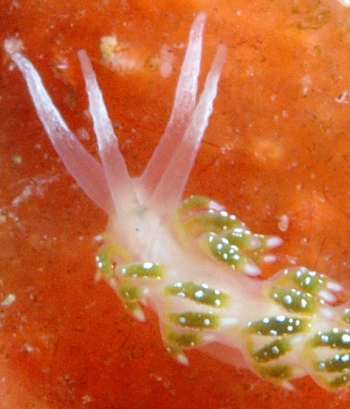
Note added 10 Sept 2007: This is almost certainly a green form of Tularia bractea. See message #20678]
Dear Ian,
It certainly seems to be C. scintillans. I assume the smaller number of ceratal rows is related to its smaller size. The colur pattern, with the opaque bright white spots certainly deserves Michael Miller's name 'scintillans'. There seem to be distinctive wrinkles on the rhinophores which I assume are because they are somewhat contracted. This is a valuable contribution to our knowledge of this rarely reported species.
Best wishes,
Bill Rudman
